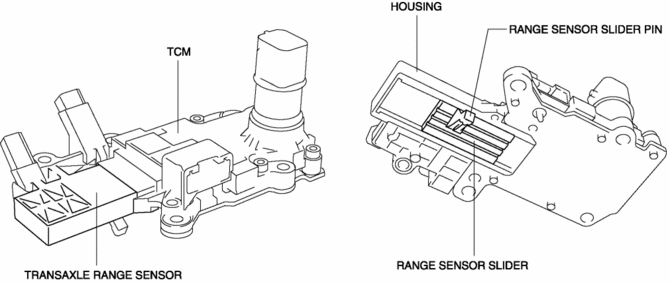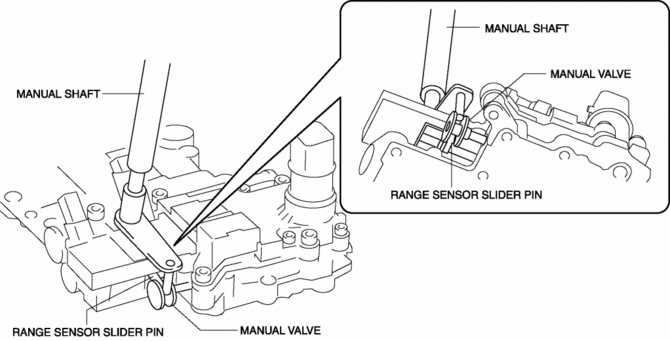Mazda CX-5 Service & Repair Manual: Transaxle Range Sensor [Fw6 A EL, Fw6 Ax EL]
Purpose/Function
-
The transaxle range sensor detects the position of the manual valve and selector lever.
-
The transaxle range sensor signal is used for automatic shift control, manual shift control, TCC control, line pressure control, direct electric shift control, learning control, engine-transaxle integration control, and the on-board diagnostic system.
Construction
-
The transaxle range sensor consists of a housing and slider which are installed to the control valve body as a part of the TCM.
-
The slider is assembled to the housing and the pin which projects from the slider and is connected to the manual valve.

Operation
-
When the selector lever is operated, the manual valve strokes via the manual shaft while the slider strokes via the slider pin.
-
The transaxle range sensor detects the signal corresponding to the manual valve position according to the slider stroke. This signal is calculated in the TCM and detected as a range position.

 Transaxle Fluid Temperature (Tft) Sensor [Fw6 A EL, Fw6 Ax EL]
Transaxle Fluid Temperature (Tft) Sensor [Fw6 A EL, Fw6 Ax EL]
Purpose/Function
The transaxle fluid temperature (TFT) sensor detects the ATF temperature
in the oil pan.
The transaxle fluid temperature (TFT) sensor signal is used for automatic
...
 Automatic
Automatic
...
Other materials:
Seat Weight Sensor Control Module Removal/Installation [Two Step Deployment
Control System]
CAUTION:
When the seat weight sensor control module is replaced with a new one, perform
the seat weight sensor calibration using the M?MDS..
1. Switch the ignition to off.
2. Disconnect the negative battery cable and wait for 1 min or more..
3. Disconnect the connectors.
...
Battery Removal/Installation [Skyactiv G 2.0]
1. Remove in the order indicated in the table.
2. Install in the reverse order of removal.
1
Negative battery cable
(See NEGATIVE BATTERY CABLE DISCONNECTION/CONNECTION [SKYACTIV-G 2.0].)
2
Positive battery cable
3
...
Non Return Valve
Purpose, Function
Assures safety by preventing fuel from returning to the fuel filler opening.
Construction
The non-return valve cannot be removed as it is installed inside the fuel
tank.
2WD
AWD
A single valve type has been adopted for the non-return v ...
